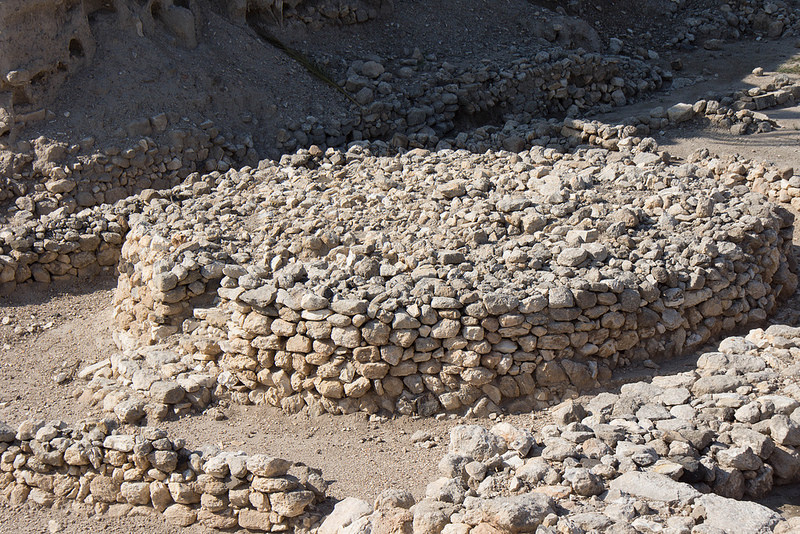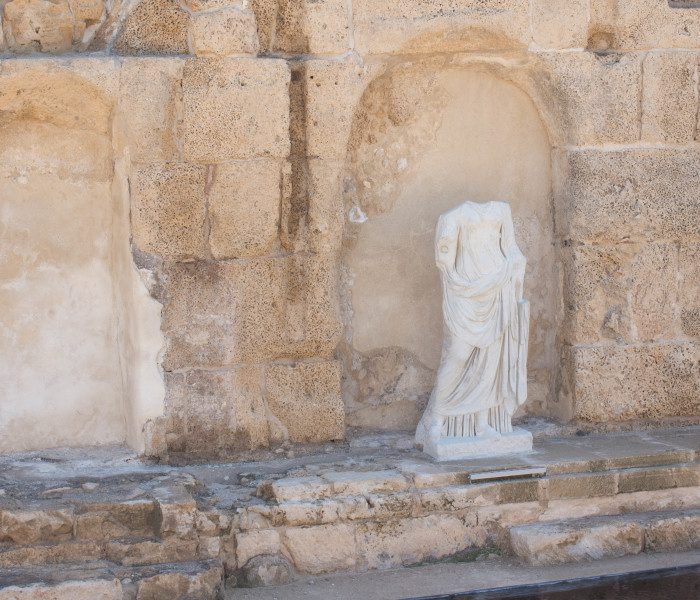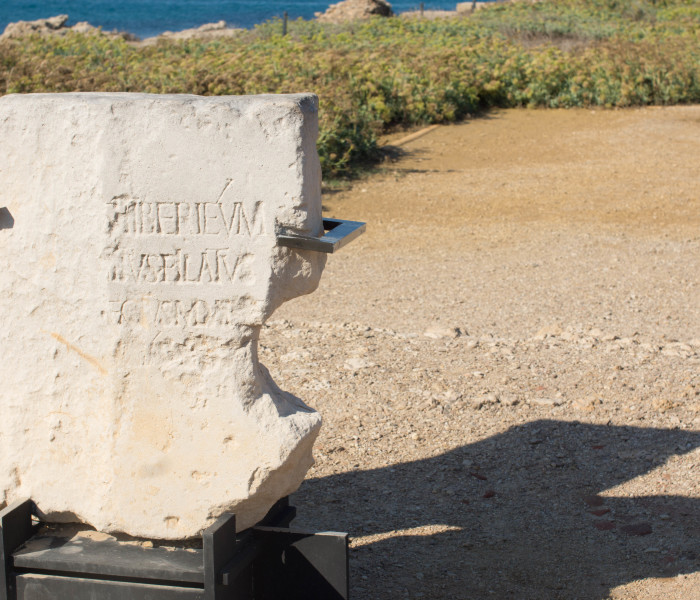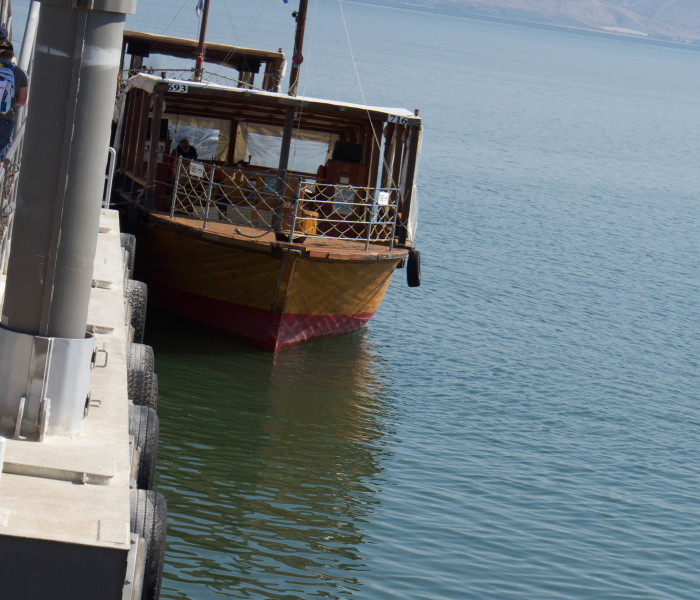Hebrew: Tel Megido / Arabic: Tell al-Mutesellim / Bible: Megiddo; Har Megiddo (Armageddon)
Coordinates: 32°35′4.64″N 35°11′0.58″E / Elevation: +510
 Megiddo overlooks the Plain of Esdraelon on the southeastern slope of the Carmel mountain range. Its strategic importance cannot be overstated.
Megiddo overlooks the Plain of Esdraelon on the southeastern slope of the Carmel mountain range. Its strategic importance cannot be overstated.  Being midway in a natural funnel between mountain ranges to the north, east and west, any movement through the valley below was readily visible. The Plain of Esdraelon (also known as the valley of Jezreel, the plain of Megiddo, and ‘Armageddon’ – a corruption of the Hebrew, Har Megiddo, which means, ‘hill of Megiddo’), has been the site of numerous battles over the past 6,000 years. According to some interpreters, the gathering of 200 million mounted troops for the final battle on earth will take place on this plain (Revelation 9:16).
Being midway in a natural funnel between mountain ranges to the north, east and west, any movement through the valley below was readily visible. The Plain of Esdraelon (also known as the valley of Jezreel, the plain of Megiddo, and ‘Armageddon’ – a corruption of the Hebrew, Har Megiddo, which means, ‘hill of Megiddo’), has been the site of numerous battles over the past 6,000 years. According to some interpreters, the gathering of 200 million mounted troops for the final battle on earth will take place on this plain (Revelation 9:16). 
History of the site: Flint tools and a few sherds discovered at Megiddo attest to human habitation at the site as early as the Neolithic period (the seventh and sixth millennia BC) and in the Chalcolithic period (the fifth and fourth millennia).
 During the reign of the Egyptian Pharaoh Thutmose III (the fifteenth century BC) Megiddo belonged to an alliance of Cannanite cities that rebelled against Egypt, under the protection of the Kingdom of Mitanni. The annals of Thutmose III describe the battle that took place in the valley at the foot of Megiddo, in which the Egyptian army defeated the rebels, plundering hundreds of chariots, thousands of horses and large quantities of grain.
During the reign of the Egyptian Pharaoh Thutmose III (the fifteenth century BC) Megiddo belonged to an alliance of Cannanite cities that rebelled against Egypt, under the protection of the Kingdom of Mitanni. The annals of Thutmose III describe the battle that took place in the valley at the foot of Megiddo, in which the Egyptian army defeated the rebels, plundering hundreds of chariots, thousands of horses and large quantities of grain.
» Read more
 Extensive excavations of the mound, revealing not less than 25 strata, commenced in 1925 with work continuing until the outbreak of the Second World War in 1939. One of the most significant finds was the water system, consisting of a vertical shaft 120 feet deep connected by a tunnel 215 feet long to a spring located outside the city walls, built during the mid-9th century BCE to protect the city’s water supply war time.
Extensive excavations of the mound, revealing not less than 25 strata, commenced in 1925 with work continuing until the outbreak of the Second World War in 1939. One of the most significant finds was the water system, consisting of a vertical shaft 120 feet deep connected by a tunnel 215 feet long to a spring located outside the city walls, built during the mid-9th century BCE to protect the city’s water supply war time.
Although first fortified in the Chalcolithic Period, the oldest surviving record of its name appears in the Temple of Karnak where Thutmose III (1479-1426) of Egypt caused an account of his battle at Megiddo in 1468 BCE inscribed on the walls. Thutmose led his army through the narrow ‘Aruna pass to take the Syrian army by surprise. The defeat of the Syrians fall of the city, after a seven month siege, enabled Thutmose to annex Canaan into his New Kingdom empire as a vassal province.  This victory initiated a period of Egyptian suzerainty in Canaan in which Megiddo played an important role for hundreds of years. Later six of the Armana Tablets (comprising the diplomatic archive of the late 18th Dynasty of Egypt) were letters sent by Biridiya, king of Megiddo, to pharaoh Amenhotep IV (Akhetaton, 1353-1336) in the 14th century BCE. In these letters, Biridiya consistently reaffirmed his loyalty to his Egyptian overlord. He pleaded also for Egyptian military assistance (100 archers!) in order to repel ‘Apiru bands which were active in his vicinity. Further mention of the town appears in the records of the Egyptian 19th Dynasty pharaohs Seti I, Rameses II and Merneptah. In the 13th century Deborah and Barak overcame Sisera near the site (Judges 4).
This victory initiated a period of Egyptian suzerainty in Canaan in which Megiddo played an important role for hundreds of years. Later six of the Armana Tablets (comprising the diplomatic archive of the late 18th Dynasty of Egypt) were letters sent by Biridiya, king of Megiddo, to pharaoh Amenhotep IV (Akhetaton, 1353-1336) in the 14th century BCE. In these letters, Biridiya consistently reaffirmed his loyalty to his Egyptian overlord. He pleaded also for Egyptian military assistance (100 archers!) in order to repel ‘Apiru bands which were active in his vicinity. Further mention of the town appears in the records of the Egyptian 19th Dynasty pharaohs Seti I, Rameses II and Merneptah. In the 13th century Deborah and Barak overcame Sisera near the site (Judges 4).
» less

In the Bible:  Megiddo is mentioned in Judges 1:27 as one of the cities which the Israelites did not conquer as commanded by God (Numbers 33:51-56), though its kings are listed as having been defeated by Joshua (Joshua 12:7, 21). The books of Judges (5:19-25), 2 Kings (9:27; 23:29-30) and 2 Chronicles (35:22) record military activity that took place at Megiddo.
Megiddo is mentioned in Judges 1:27 as one of the cities which the Israelites did not conquer as commanded by God (Numbers 33:51-56), though its kings are listed as having been defeated by Joshua (Joshua 12:7, 21). The books of Judges (5:19-25), 2 Kings (9:27; 23:29-30) and 2 Chronicles (35:22) record military activity that took place at Megiddo.
» Read more
» less

 Why we stopped at Megiddo: 1) as noted above, Megiddo is one of the most excavated historical sites in the world. Archaeological methods, and in particular, strata layer dating, is easily seen in the ruins; 2) Tel Megiddo has a fairly intact pagan altar, a good reminder of how evil can cloak itself in religion; 3) the tunnel dug through solid rock gives an appreciation of the engineering prowess of ancient cultures; and 4) the panoramic view of the valley of Megiddo (‘Armageddon’) brings to life passages of prophecy.
Why we stopped at Megiddo: 1) as noted above, Megiddo is one of the most excavated historical sites in the world. Archaeological methods, and in particular, strata layer dating, is easily seen in the ruins; 2) Tel Megiddo has a fairly intact pagan altar, a good reminder of how evil can cloak itself in religion; 3) the tunnel dug through solid rock gives an appreciation of the engineering prowess of ancient cultures; and 4) the panoramic view of the valley of Megiddo (‘Armageddon’) brings to life passages of prophecy. 
Categories: Locations
Tags: Tel Megiddo.






Comments are closed.